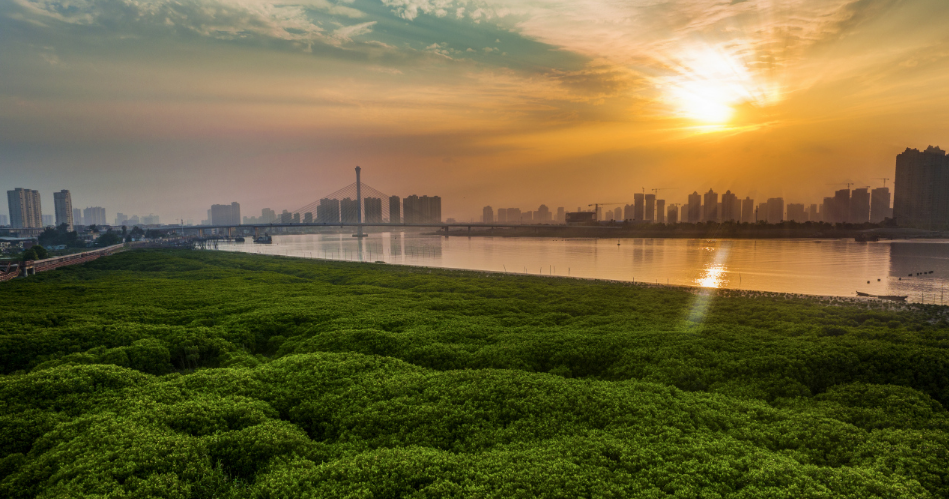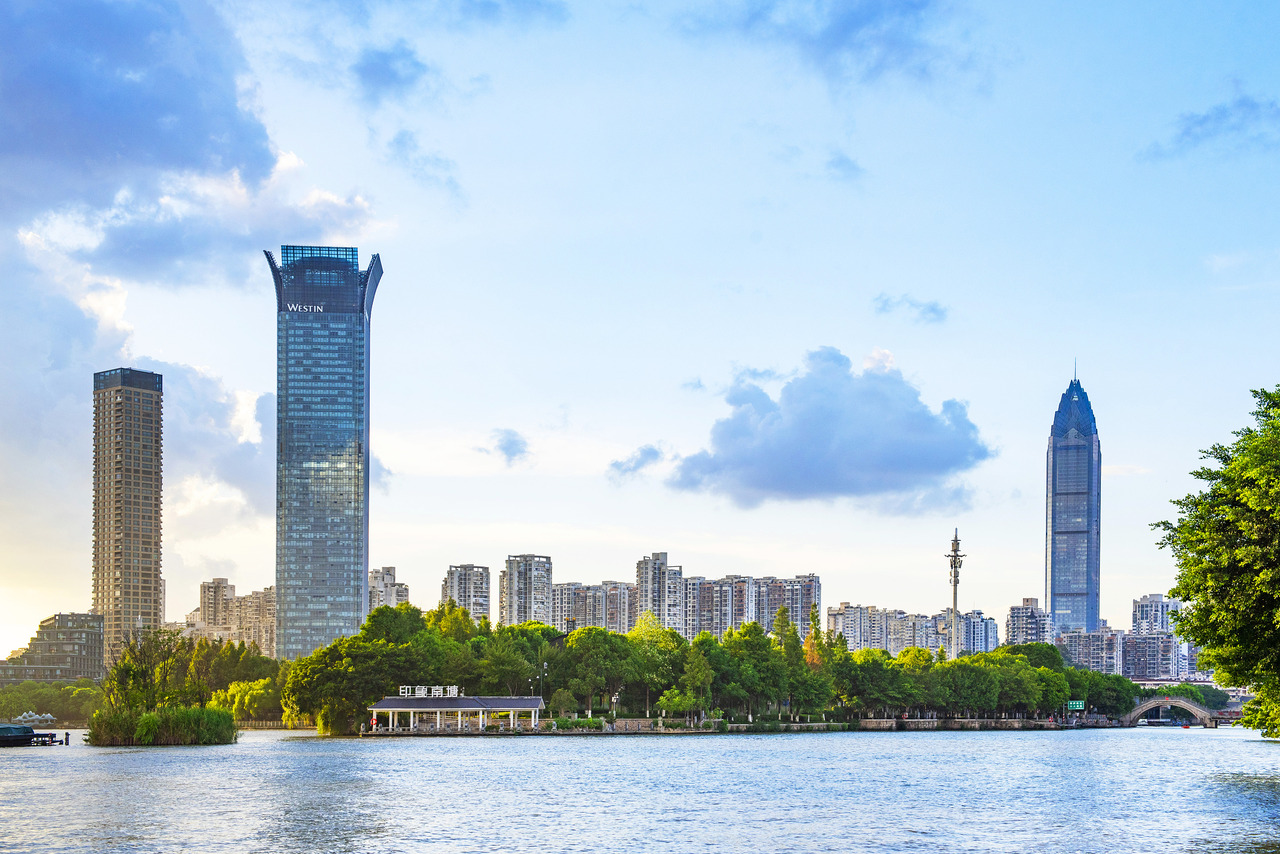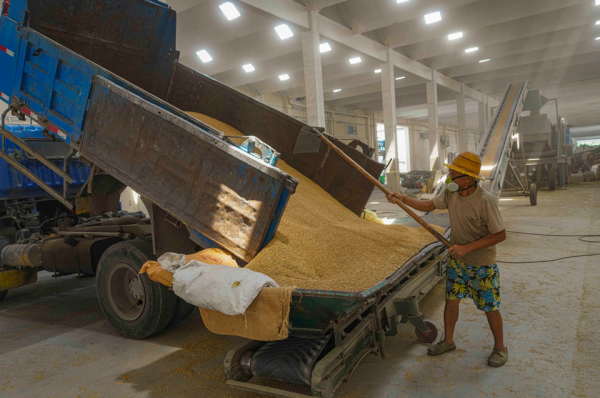The Sea Grows a Forest: Longgang’s Tidal Miracle
时间:2025-08-07 11:06:20 来源 : DiscoverWenzhou 作者 : Zhao Chenzhang
At the 15th Meeting of the Conference of the Parties to the Ramsar Convention (COP15) recently held in Zimbabwe, Wenzhou, China was officially recognized as a new"International Wetland City." Among the highlights of Wenzhou's presentation was a promotional video showcasing rare and endangered birds thriving in its restored wetlands— a vivid testament to the city's ecological progress. Black-faced spoonbills glide gracefully across tidal flats, while black-headed gulls frolic on mudflats— scenes now routinely witnessed in Longgang, a rising star in coastal wetland conservation.
Strolling along the riverside boardwalk in Xinmeizhou Community, Longgang, visitors are greeted by lush, tiered mangrove forests swaying gently in the breeze— a living green barrier between land and sea. Since becoming a county-level city in 2019, Longgang has intensified its mangrove restoration efforts, investing nearly RMB 100 million in ecological upgrades to both sides of its seawalls. These efforts have added 1,000 mu (about 67 hectares) of new mangroves— double the total planted over the previous two decades. Today, the city's mangrove coverage reaches 1,200 mu, playing a vital role in wave reduction, coastal protection, heavy metal absorption, and improving water exchange and self-purification in marine ecosystems.

The Longgang Mangrove Provincial Wetland Park. Photograph provided by Chi Changfeng
The Longgang Mangrove Provincial Wetland Park, located in Xinmeizhou Community, lies at one of the northernmost edges of China's mangrove ecosystems. Spanning 1.53 square kilometers, it includes around 600 mu of dense mangroves with trees exceeding 5 meters in height— among the most mature stands in Zhejiang Province.
The thriving growth is not just due to long-term planting, but also ideal local conditions. Situated at the estuary of the Oujiang River, the area offers rich nutrients, suitable salinity, and favorable temperatures for mangroves. The Zhejiang Institute of Subtropical Crops has conducted long-term monitoring and research here, successfully developing the"Longgang Qiuqie" mangrove mother tree variety, which has passed provincial certification. This strain now supplies over 4 million high-quality seedlings annually— the primary source for mangrove restoration across Zhejiang.
"Most of the mangroves in our province now come from Longgang's certified seedlings,"said an institute official.
Today, Longgang's 7.81-kilometer mangrove coastline accounts for 23% of its total mainland shoreline, with mangrove area making up 16.5% of the provincial total.
"Y21 is back!"This year, the black-faced spoonbill with ring code Y21 returned once again from South Korea— a familiar"guest"now regularly recorded by local birdwatchers. Thanks to rich food sources and high-quality habitats, Longgang has become a crucial stopover on the East Asian-Australasian Flyway, hosting hundreds of thousands of migratory birds each winter.
Since 2020, ecological monitoring in Longgang's mangroves has recorded over 100 bird species, including rare first-time sightings in China such as the Black-tailed Godwit. The area is now home to three National Class I protected birds— the Black-faced Spoonbill, Black-headed Gull, and Yellow-billed Egret— and eight Class II species. In the coastal wetlands of the New Town Reclamation Zone, a total of 59 nationally protected bird species have been documented, including 10 Class I and 49 Class II protected animals.
This surge in rare bird sightings reflects Longgang's rapidly rising ecological value and has turned it into one of Wenzhou's most popular birdwatching destinations, attracting nature photographers and eco-tourists from across the country.
Longgang has chosen not to isolate its wetlands, but to open them up. Boardwalks allow the public to walk among the mangroves, fostering appreciation and stewardship. Ecological restoration goes hand-in-hand with science education— local rangers lead eco-tours and school field trips, teaching students about mangrove growth, fiddler crabs, and mudskippers. Thousands have participated in these immersive learning experiences.
To safeguard these hard-won gains, Longgang protects its mangroves"like the eyes."Multiple research teams conduct regular monitoring of biodiversity, environmental factors, threats, and carbon sequestration. The city also strengthens oversight of ecological redlines in estuaries and key coastal wetlands to prevent degradation.
Today, Longgang's mangroves sequester 570 tons of carbon annually, with estimated total ecological and economic value reaching RMB 890 million per year. The area is evolving into a green space where production, life, and ecology coexist in harmony.
How can ecological protection drive rural revitalization? Young locals are bringing fresh ideas. The community has launched eco-education routes, turning conservation into storytelling.
Meanwhile, the Longgang Seawall Safety and Resilience Project— spanning over 33 kilometers along the Nan'ao River and eastern coastline— is integrating ecological design with urban development. By upgrading seawalls, building ecological sluices, and creating"city balconies,"the project aims to form a"Coastal Rainbow Belt"blending culture, tourism, sports, and leisure.
"This section of the project is about to break ground,"said He Jinlai, a local official. With more facilities on the way, Longgang aims to develop recreational fisheries, eco-tourism, and seaside experiences, transforming its"green beauty"into"golden value"— a living example of the philosophy that"lucid waters and lush mountains are invaluable assets.”(Zhao Chenzhang)


